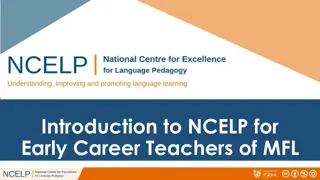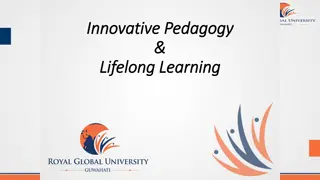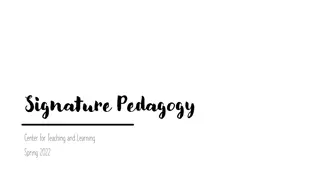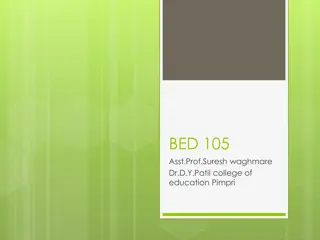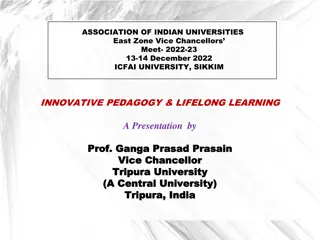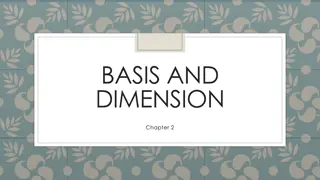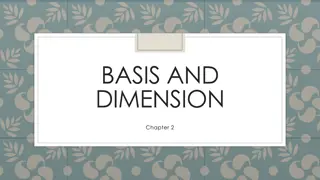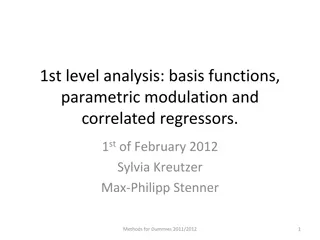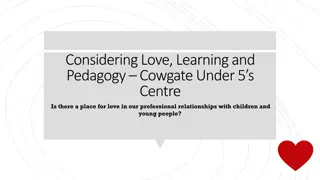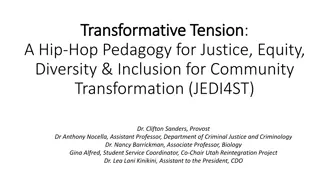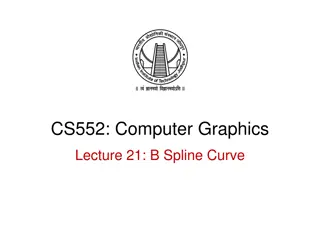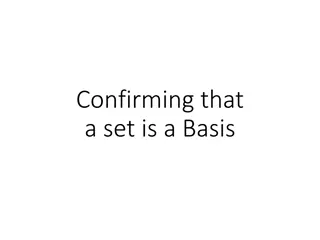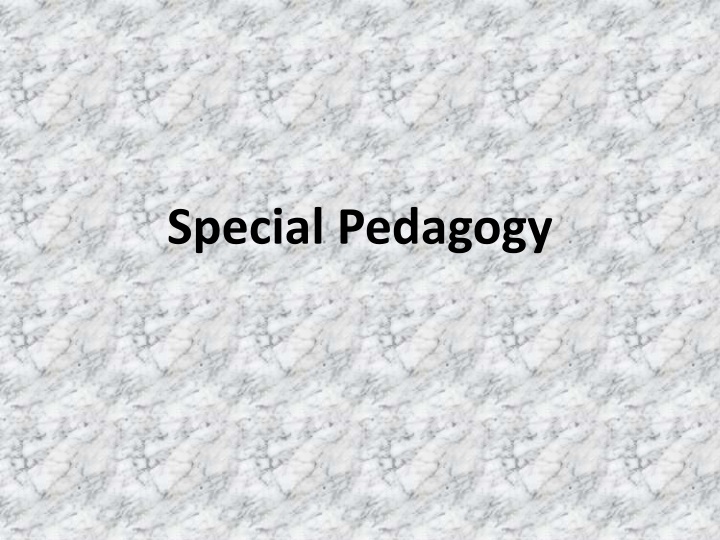
Special Pedagogy for Education and Development
Explore the importance of special pedagogy in addressing the educational and developmental needs of individuals with disabilities, both physical and psychological. Learn about educational environments, the subject of special pedagogy, goals, historical conceptions, and recent humanistic tendencies in this field.
Download Presentation

Please find below an Image/Link to download the presentation.
The content on the website is provided AS IS for your information and personal use only. It may not be sold, licensed, or shared on other websites without obtaining consent from the author. If you encounter any issues during the download, it is possible that the publisher has removed the file from their server.
You are allowed to download the files provided on this website for personal or commercial use, subject to the condition that they are used lawfully. All files are the property of their respective owners.
The content on the website is provided AS IS for your information and personal use only. It may not be sold, licensed, or shared on other websites without obtaining consent from the author.
E N D
Presentation Transcript
Demarkation of a branch of special pedagogy The importance lies in a special education and development of those people who have special educational needs Special pedagogy is concerned on the rules of education and development of disadvantaged people (physically as well as psychically or socially) What is education (de iure and in fact) from the point of special pedagogy??? Educational environment
The subject of a special pedagogy Subject of SP people with disadvantages and so with specific needs To satisfy specific needs (they are determined by a character of a handicap), there is necessary to apply special procedures and methods Main needs educational need, need of social self-realization and need of self- development
Goals of a special pedagogy Main goals 1) to reach a maximal possible socialization of disadvantage human (with a respect to a character, extent and seriousness of a disadvantage in a certain area - that is also conected with a necessarity of a creation of suitable conditions 2) to reach a change in attitudes of major part of population (attitudes to disadvantaged citizens) Other goals to reach a certain grade of education or a sequential development in a certain sphere
Historical and recent conceptions of special pedagogy Visible sequential development of attitude and behaviour towards disadvantaged people The attitude of a major population: - Represive (disinterest, refusing of helping, elimination; antics and early medieval age) - Segregative (the exclusion from society; only random help, minimal possibility of a self-realisation; medieval age) - Charitative (the label of poor =) the need fo helping or a treatment; church orders etc.; since the rennaisance started) - Humanistic (the principle of a natural dignity of every human)
Recent special pedagogy Humanistic tendencies (prevailing nowadays) - An effort to a maximal possible integration - Indicators of a society level - Very different state in different makroregions - Creation of material, ekonomical and psychosocial conditions - The quality of social and consulting services - Legislative
The main affiliated scientific branches Pedagogy Psychology (evolutionary, pedagogical, social, psychopatology etc.) Medicine (somatology, psychiatry etc.) Biology (physiology, anatomy) Sociology Philosophy Ethics
The division of a special pedagogy - important because of a different character, extent and level of a disadvantage (so, there are different demands on a compensation and help) - the division reflects kind of disorder and also the consequent handicap
The division of special pedagogy II. Ethopedy (education, upbringing, therapy and correction of behaviour patterns and moral education) Psychopedy (education, upbringing, rehabilitation and therapy of people with mental disadvantage) Somatopedy (education, upbringing, rehabilitation and therapy of people with physical disadvantage, illness, helath weakening or lowered mobility) Logopedy (education, upbringing, rehabilitation and therapy of people with communication disadvantage) Surdopedy (education, upbringing, rehabilitation and therapy of people with hearing disadvantage) Oftalmopedy (education, upbringing, rehabilitation and therapy of people with optical disadvantage); X typhlopedy
Other subdisciplines of special pedagogy Special pedagogy of people with combined handicap Special pedagogy of people with partial handicap (mainly specific disorders of learning (SPU) mainly an area of ethopedy, disadvantage in the field of fullfillment of school demands - international classification labels partial handicaps as disorders)
Handicaps clasification Disorder = loss or abnormality in psychological, physiologal or anatomical function or structure Handicap = unfavourable state or situation for a human following from a disorder or a defect, which limits roles fulfillment or making it impossible (in comparison to a major population) Disadvantage = identical with the term handicap, only terminological matter
Handicaps and disadvantages clasification in accordance to a kind of disorder a) Somatical disorders (as a consequence of ilness, injury or a loss of mobility congenital as well as gained) b) Communication disorders (connected with stimulus perception, processing and nosequent reaction) c) Mental disorders (disadvatage in a field of cognitive abilities; congenital mental retardation, gained demency) d) Behaviour disorders (the main question for classification is their social seriousness and dangeroussness) - Disocial behaviour - Asocial behaviour - Antisocial behaviour
Handicaps and disadvantages clasification in accordance to a level of disorder Handicaps and not serious disorders (minimal differences from the standard, common pedagogical means are enough, full integration) Handicaps and middle level disorders (special methods and approach are necessary, participation of specialists and special institutions often necessary) Handicaps and high level disorders (need of a special all-day care, full dependence on the help of environment, limited possibilities of an education and social self-realization)
Handicaps and disadvantages clasification in accordance to a time of their genesis Handicaps and birth disorders Handicaps and perinatal disorders Handicaps and postnatal disorders
Handicaps and birth disorders a) Genetical predispositions (disorder of a functon or a structure of genetic aparatus, chromozomal deviations and aberations for example Down syndrom etc.) b) An influence of teratogennic factors - Chemical factors (medicins, alcohol, nicotin, drugs etc. during a pregnancy) - Physical factors (the influence of radiation during a pregnancy etc.) - Biological factors (viral and other infectious diseases during a foetus development for example rubella; further stress and deprivation); recent question of vaccination
Handicaps and perinatal disorders Mainly consequencies of birth complications, thrifty or very long birth - Consequencies of an asfyxion (for example winding of a an umbilical cord or breathing of a foetal) - Consequencies of a mechanical damage of a foetus (compression of a head and consequent cerebral haemorrhage)
Handicaps and postnatal disorders An influence of chemical, biological and social factors - Chemical (analogous to prenatal disorders alcohol, drugs, medicins, poisons etc., further carcinogenic agents) - Biological factors (viral and infectious diseases for example inflammatory brain diseases; injuries etc.) - Social factors (improper upbringing conditions, low social level, stress, deprivation, etc., psychical or senzorical izolation)
Disadvatages and possibilities of an integration The attitude of society is moving among 2 poles integration and segregation The necessarity of integration borders demarcation borders are given mainly by a kind and degree of disadvatage Integration = an effort to a full involvement of a handicaped human and his/her fusion with the society; in according to WHO, it is also social rehabilitation and an ability to participate on common social processes Integrated education = full involvement of a human to a common edcational process (together with intact people)
Models of integration attitudes Medical model (rising up from biological causes, the goal is a treatment and overcoming of a handicap, the change of school system is not necessary, integration = to adapt himself or herself) Socially-patological model (rising up from social problems, the basis is a social adaptability and diskcimination, integration is supported by a special therapy Environmental model (how to change school etc. itself to be friendly to a disadvataged human; the change of an environment) Antropological model (primary, the main thing is not an improving of environment, but better interpersonal relations and interaktion, very important is respect with regards to an uniquity of each human and his or her needs)

